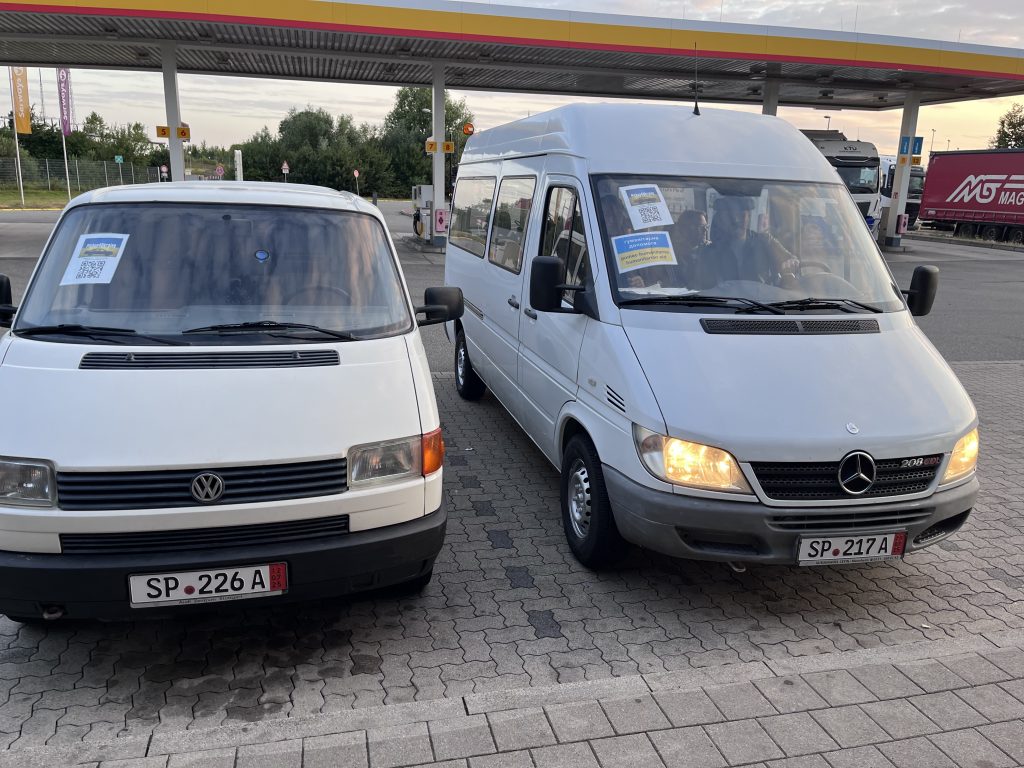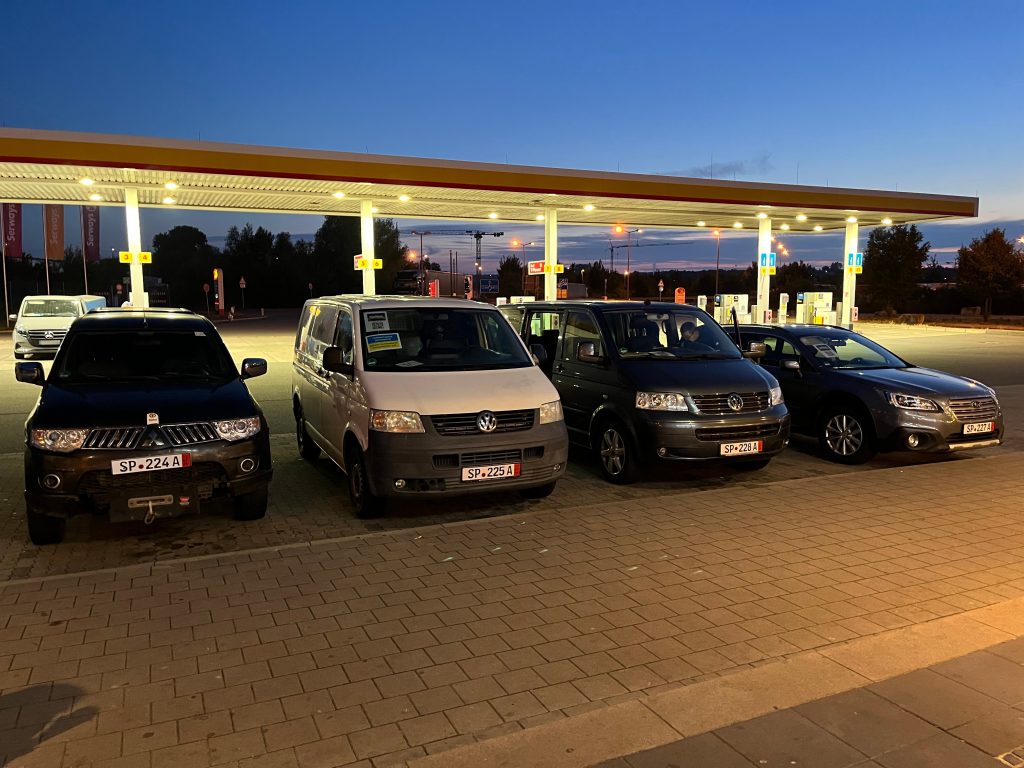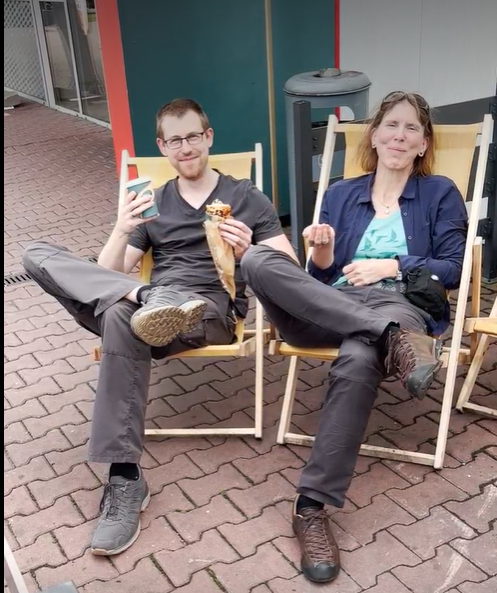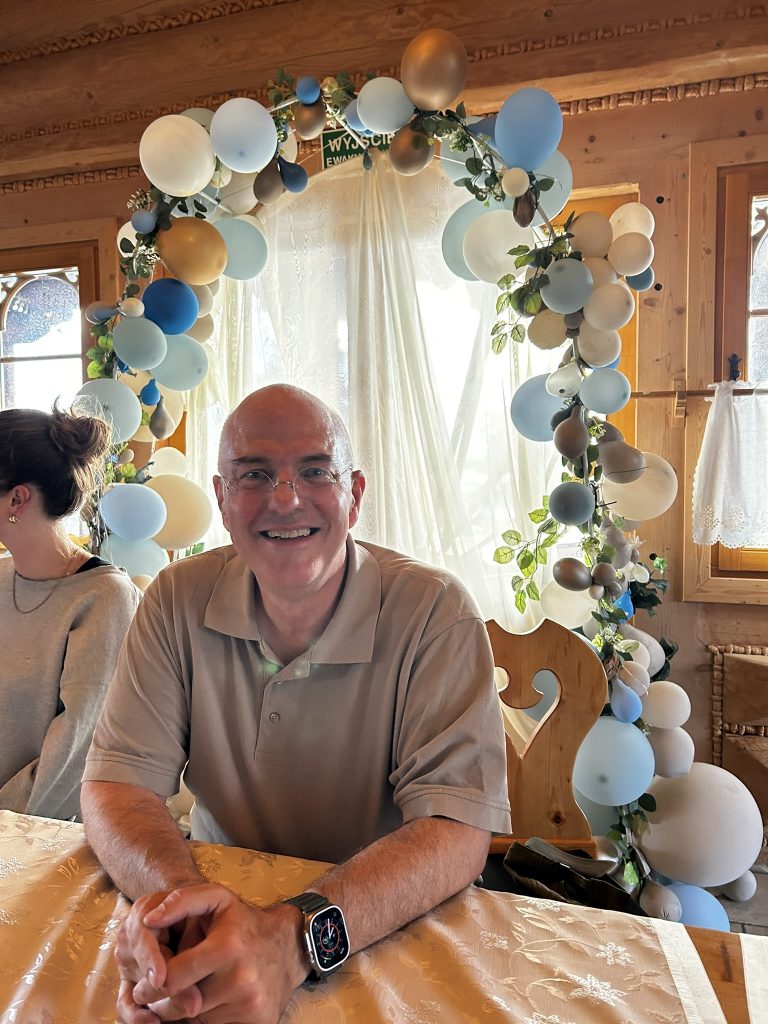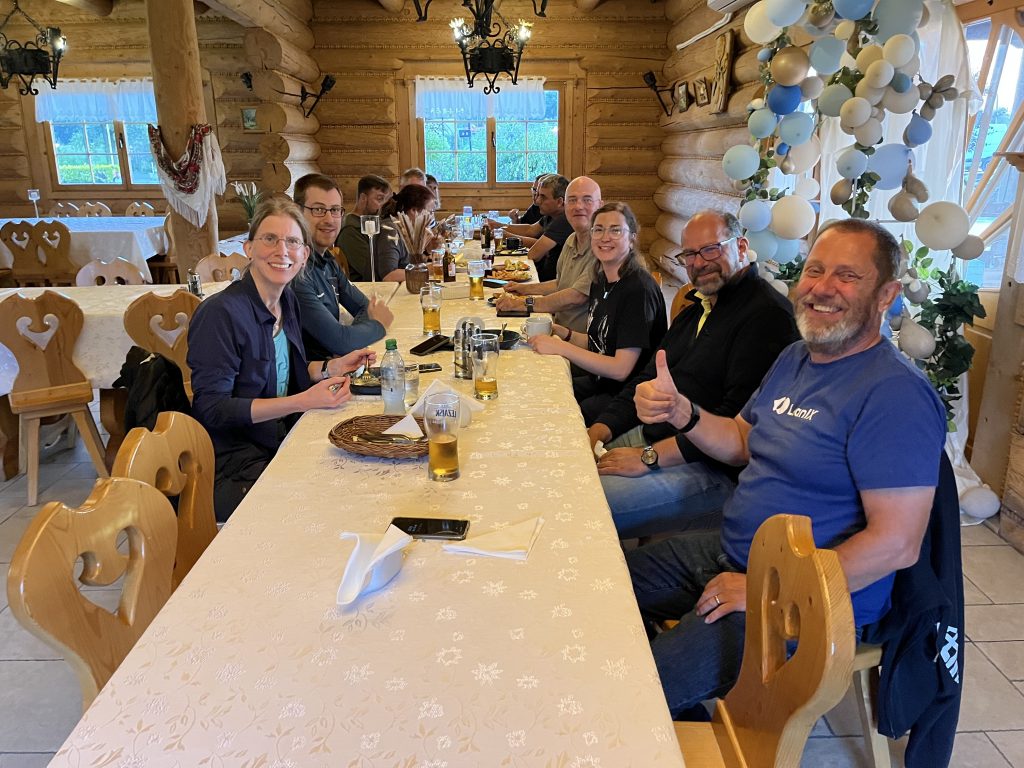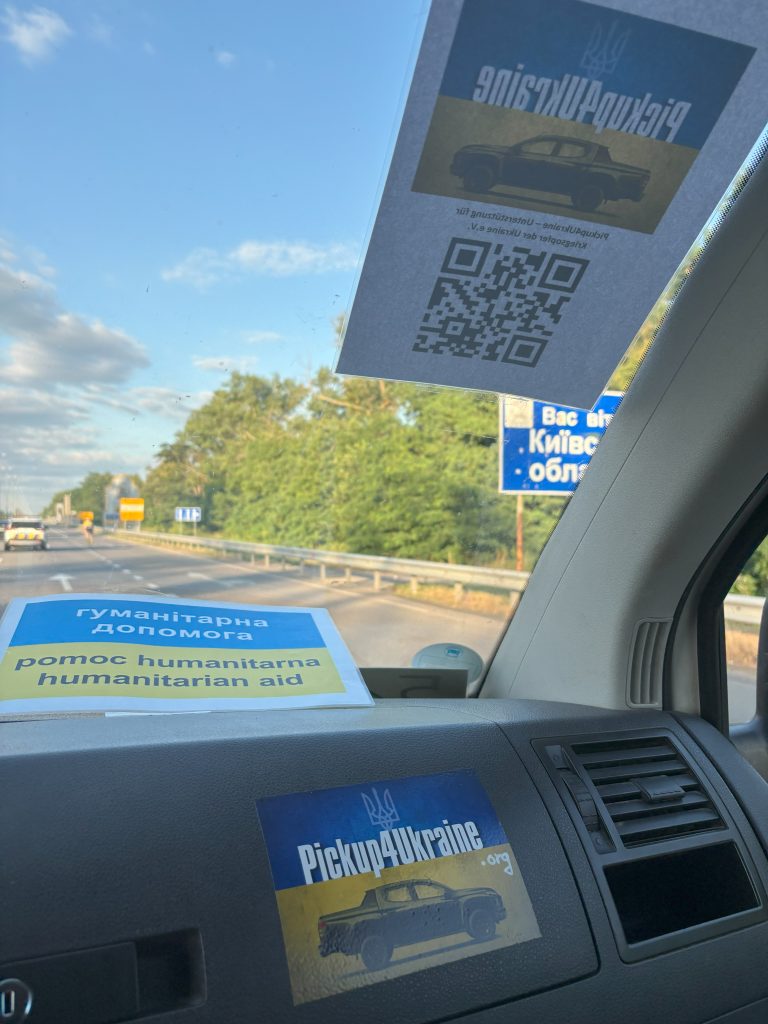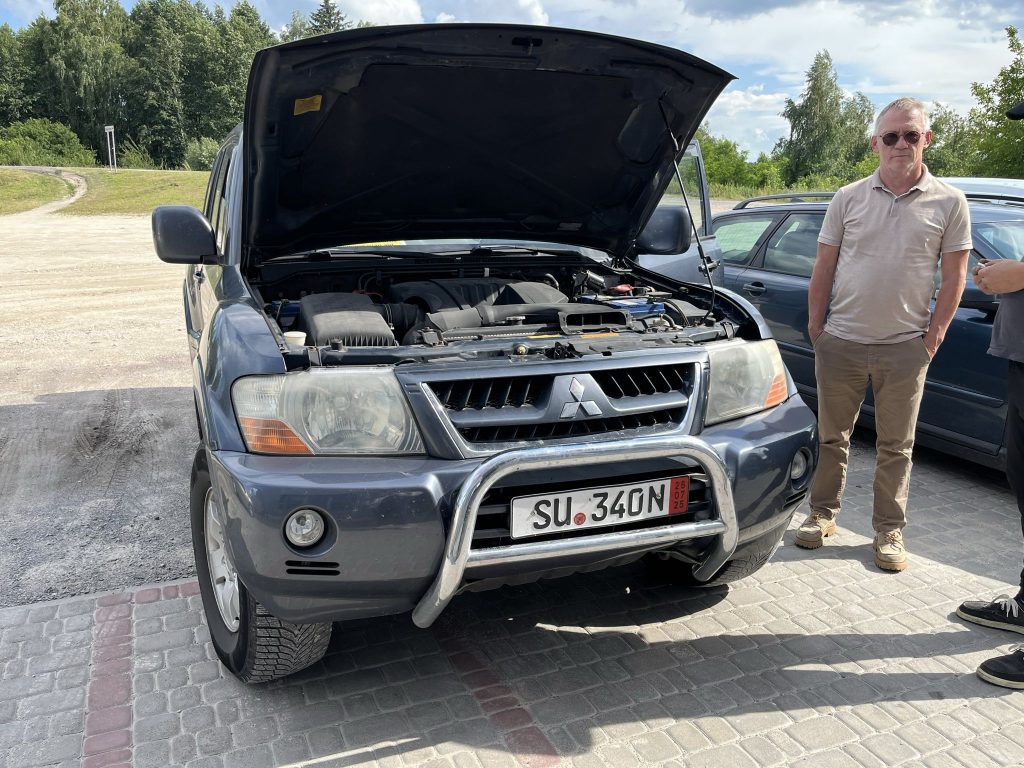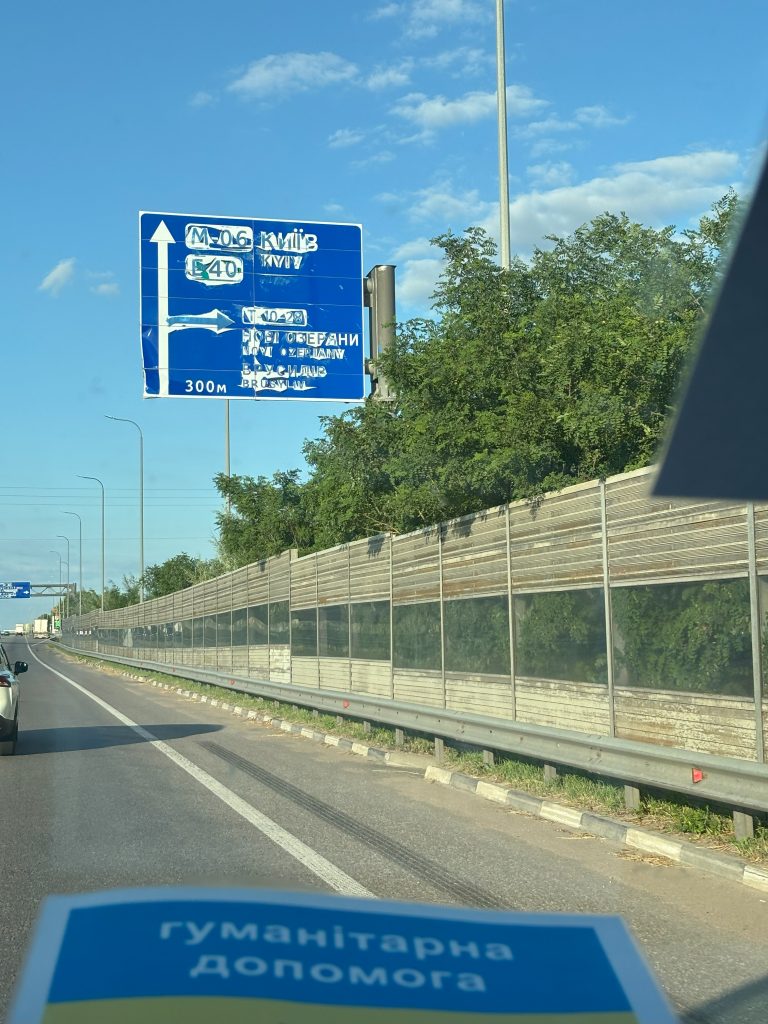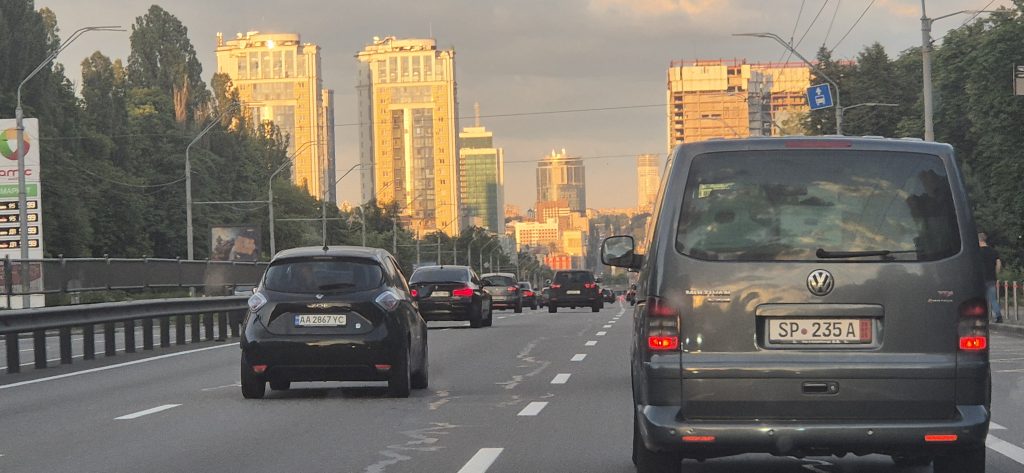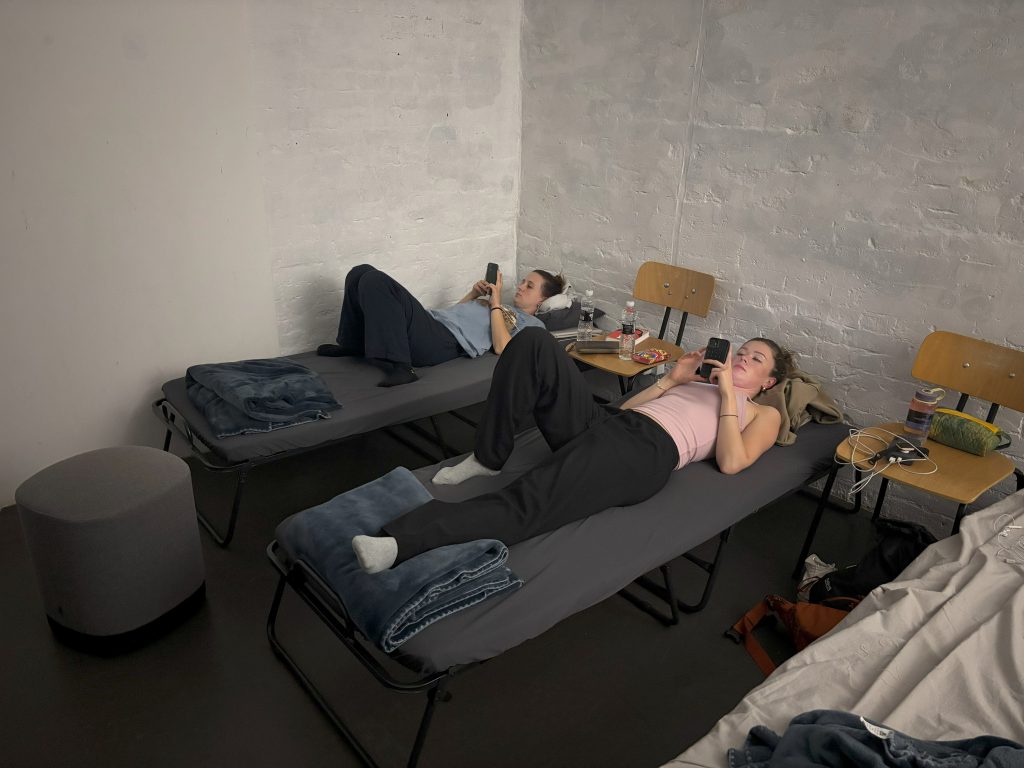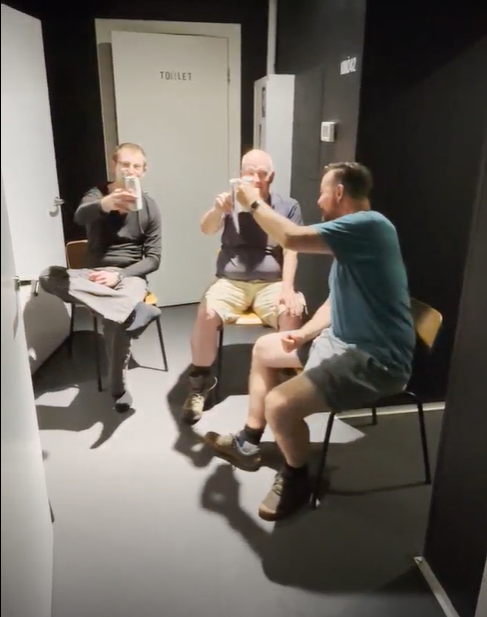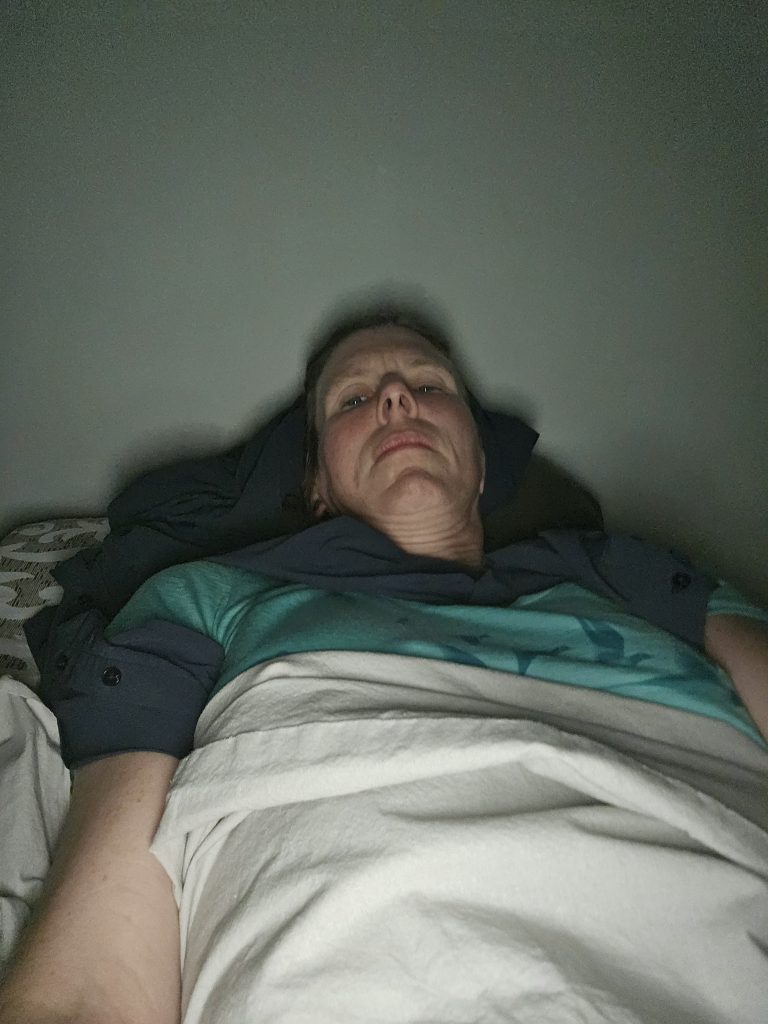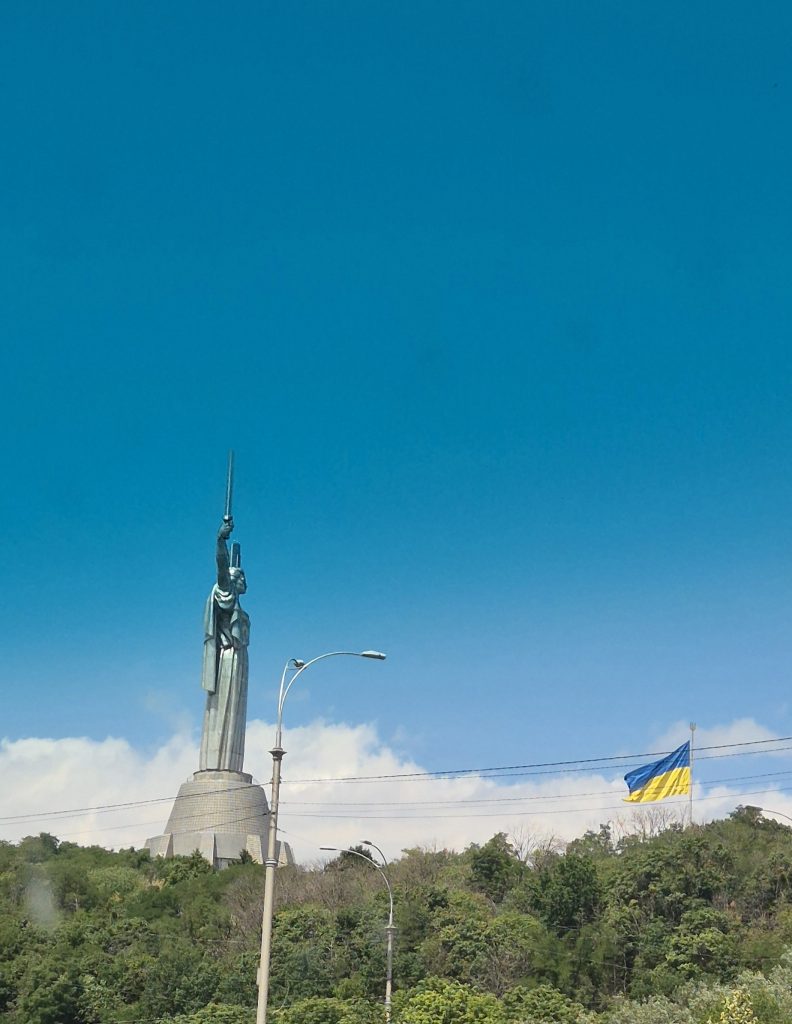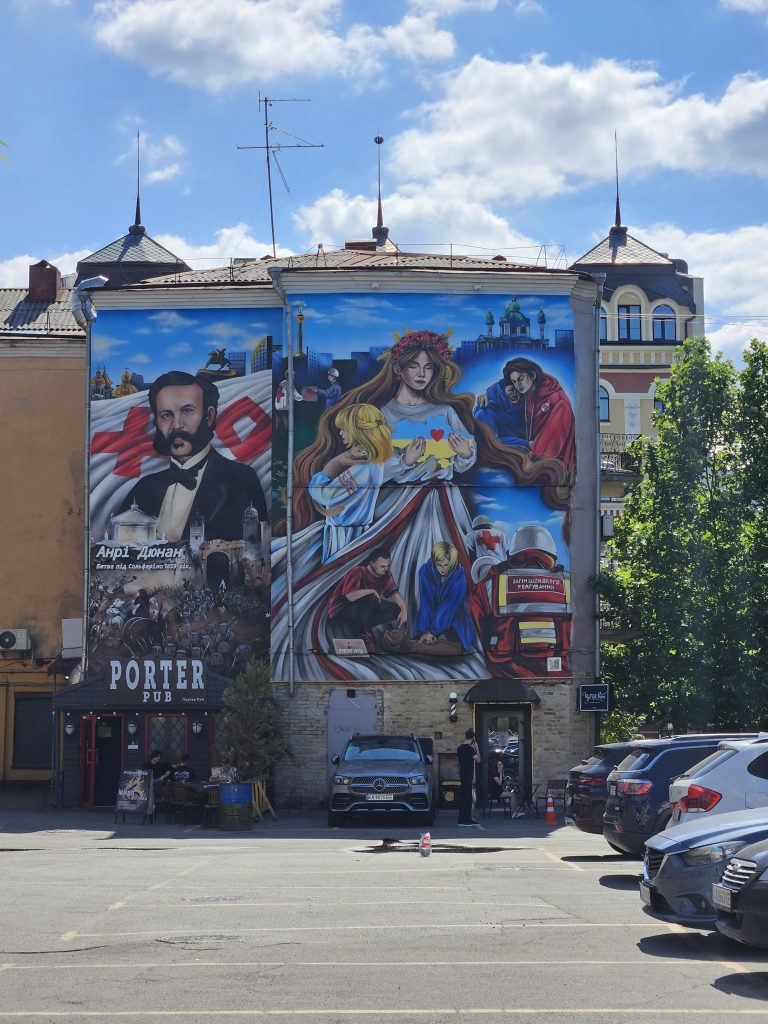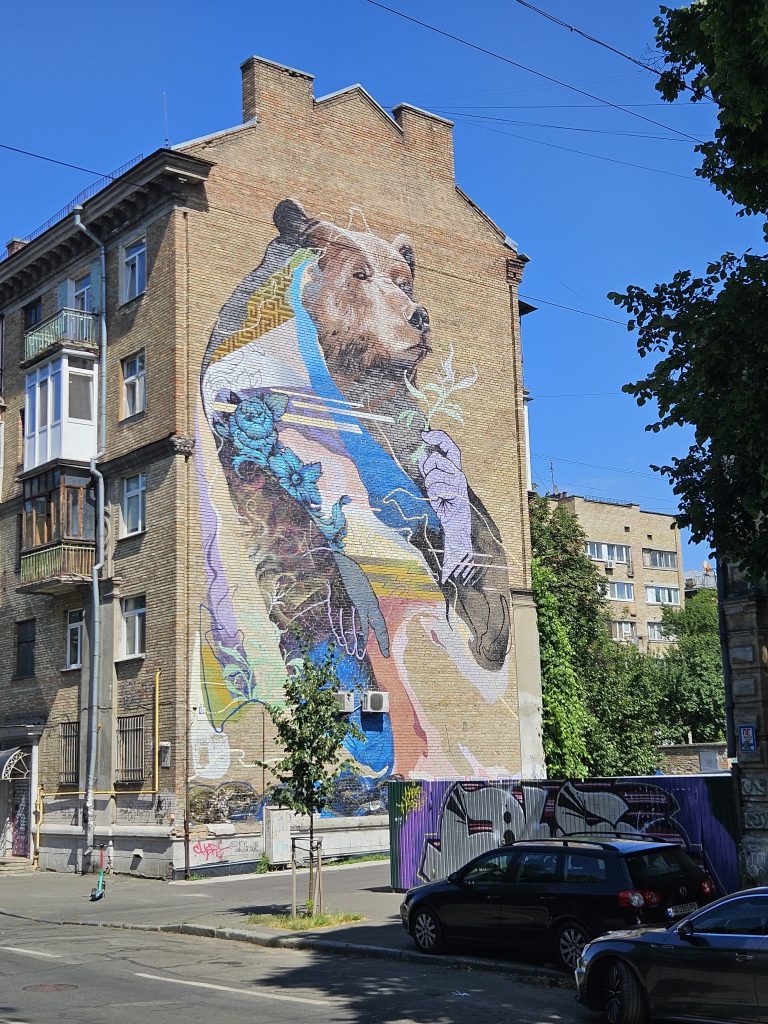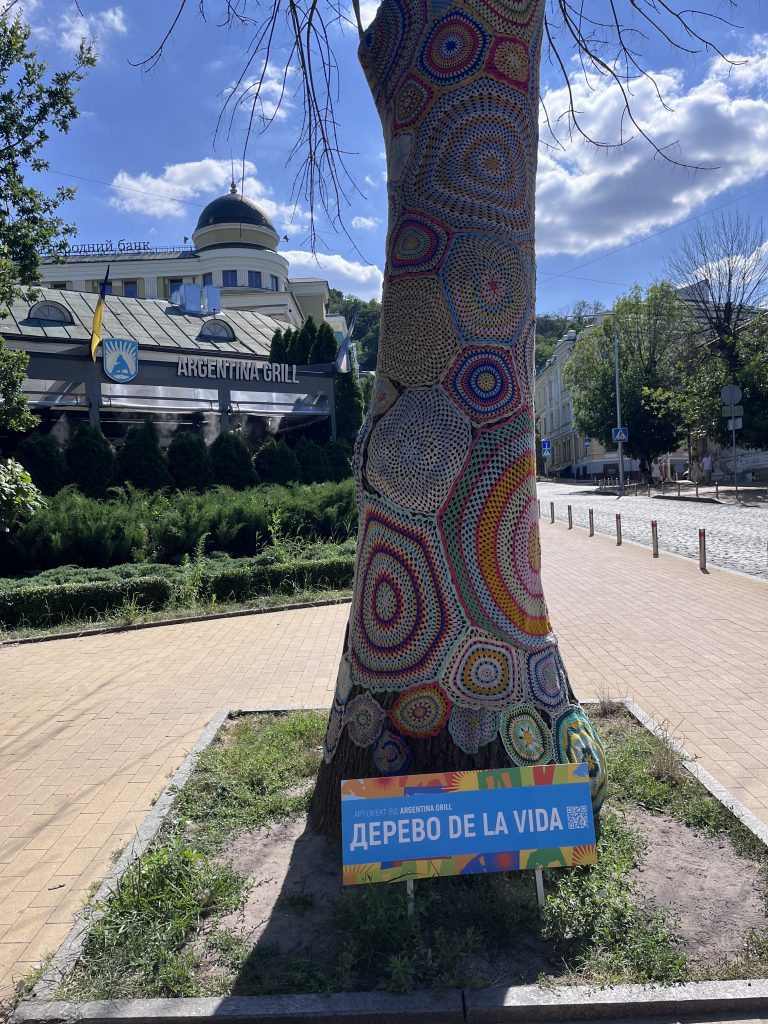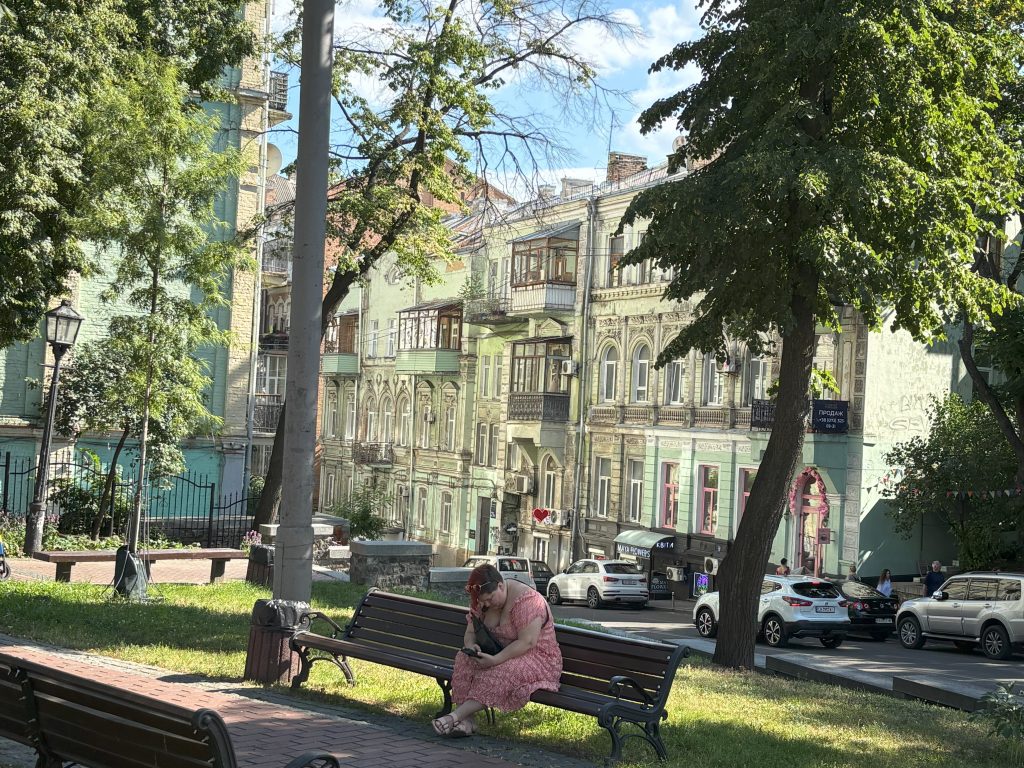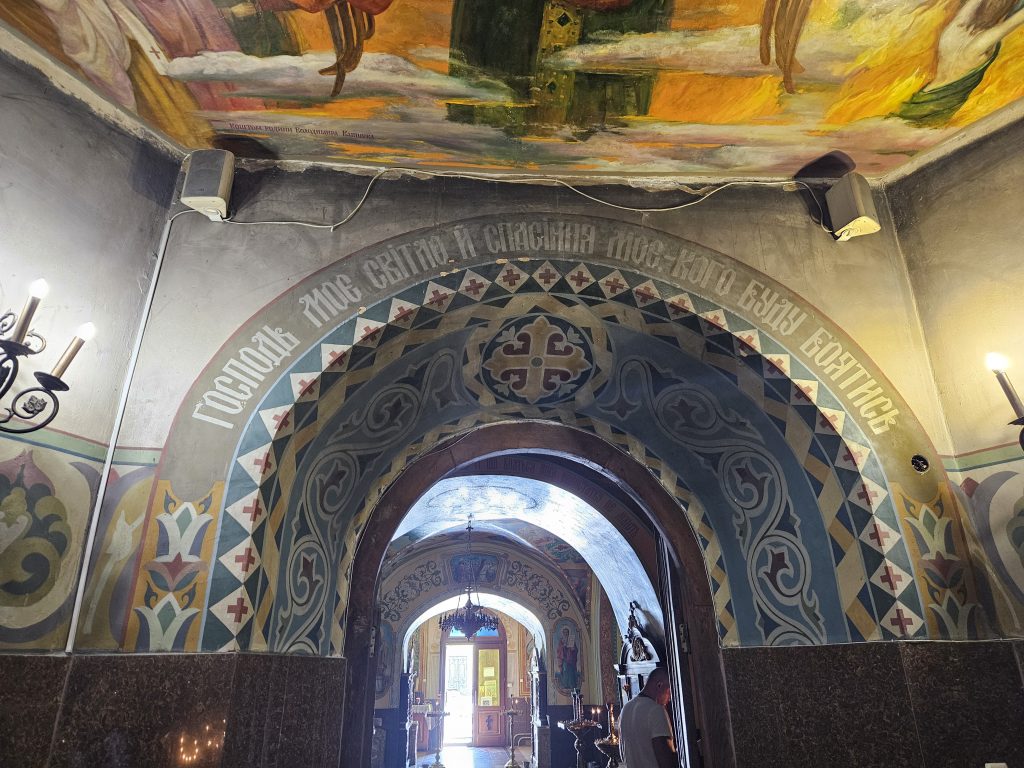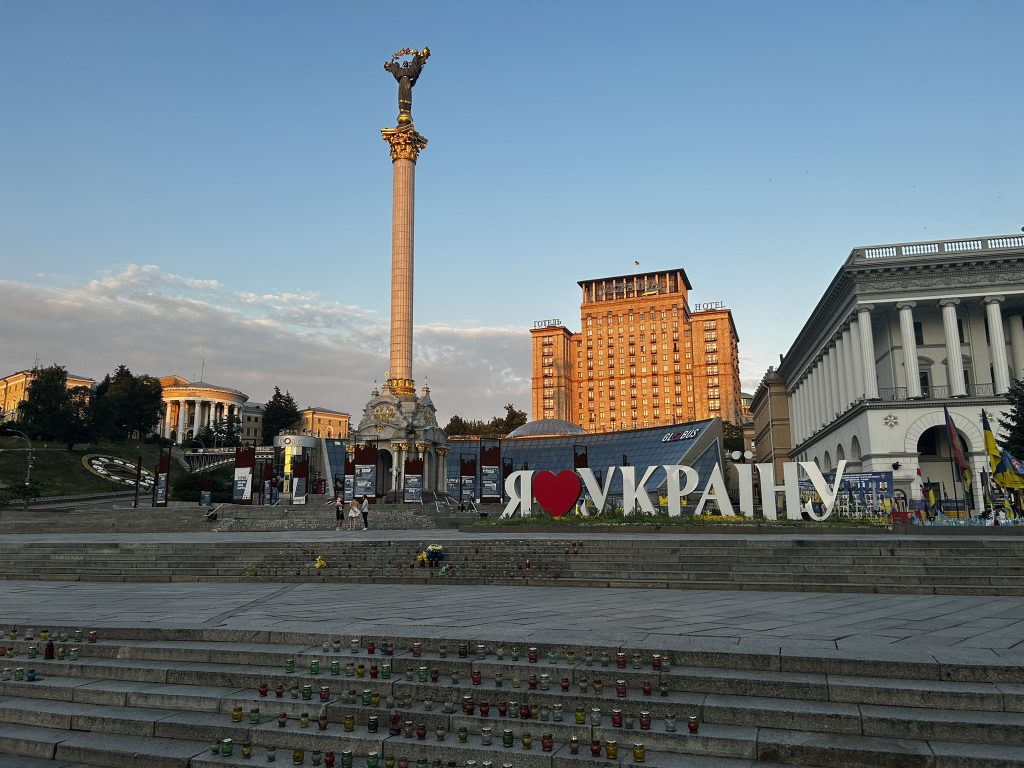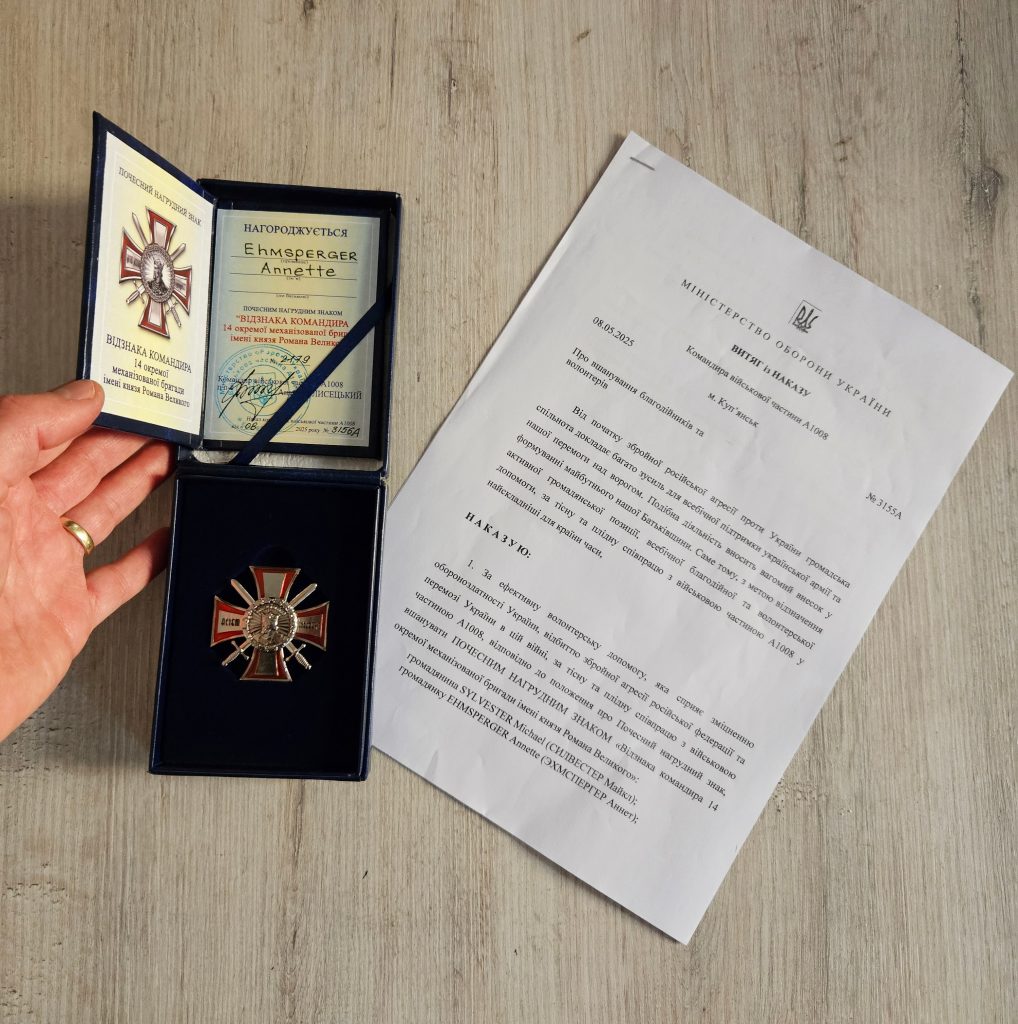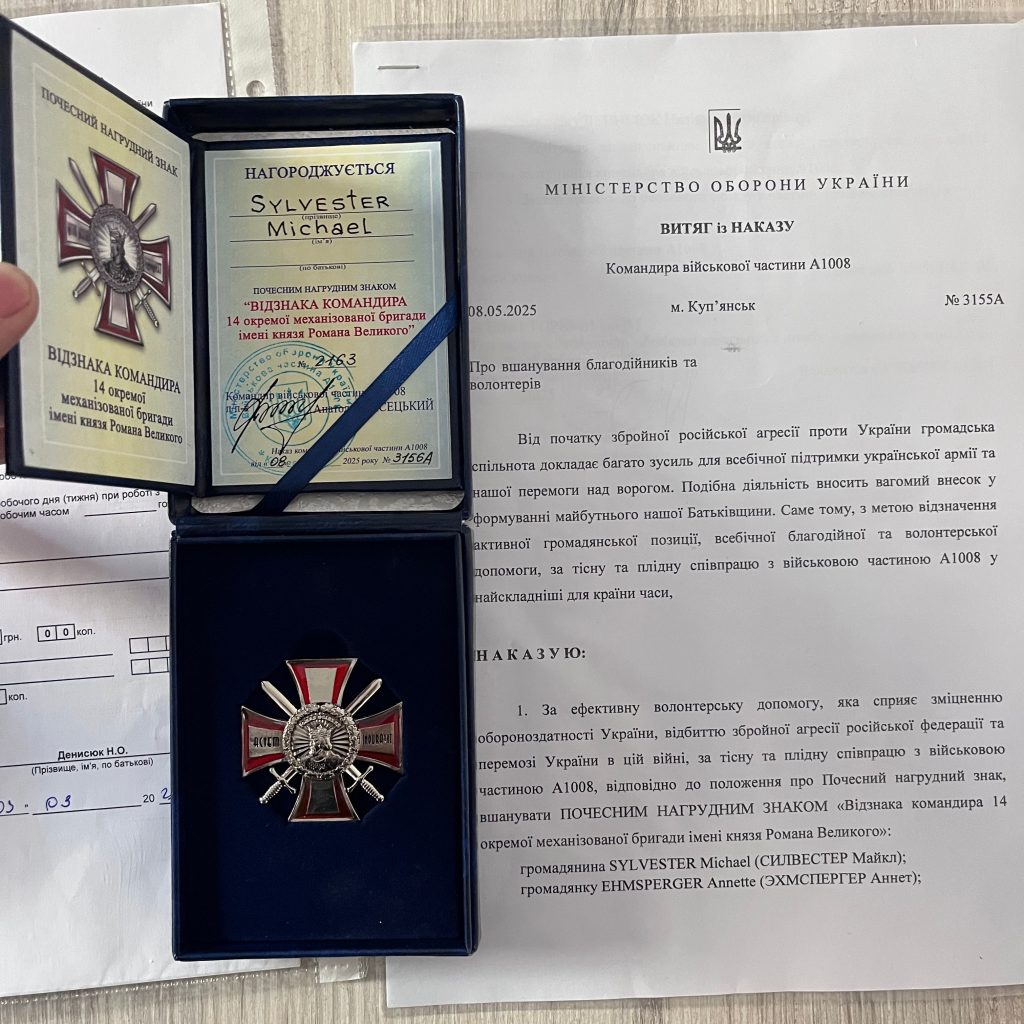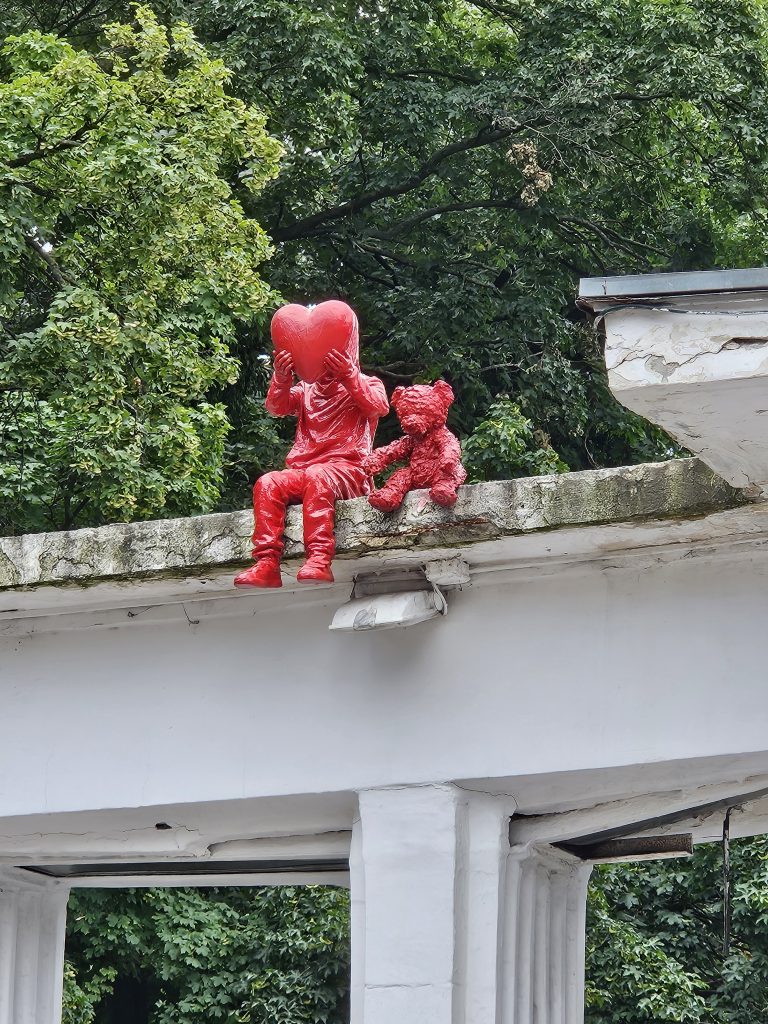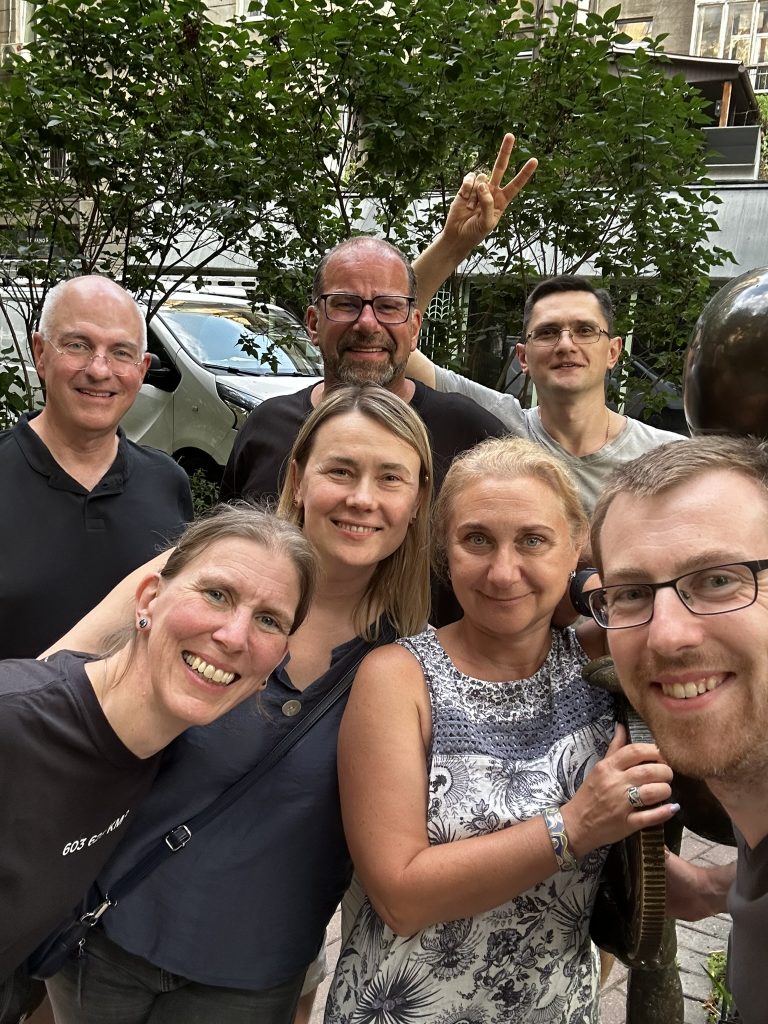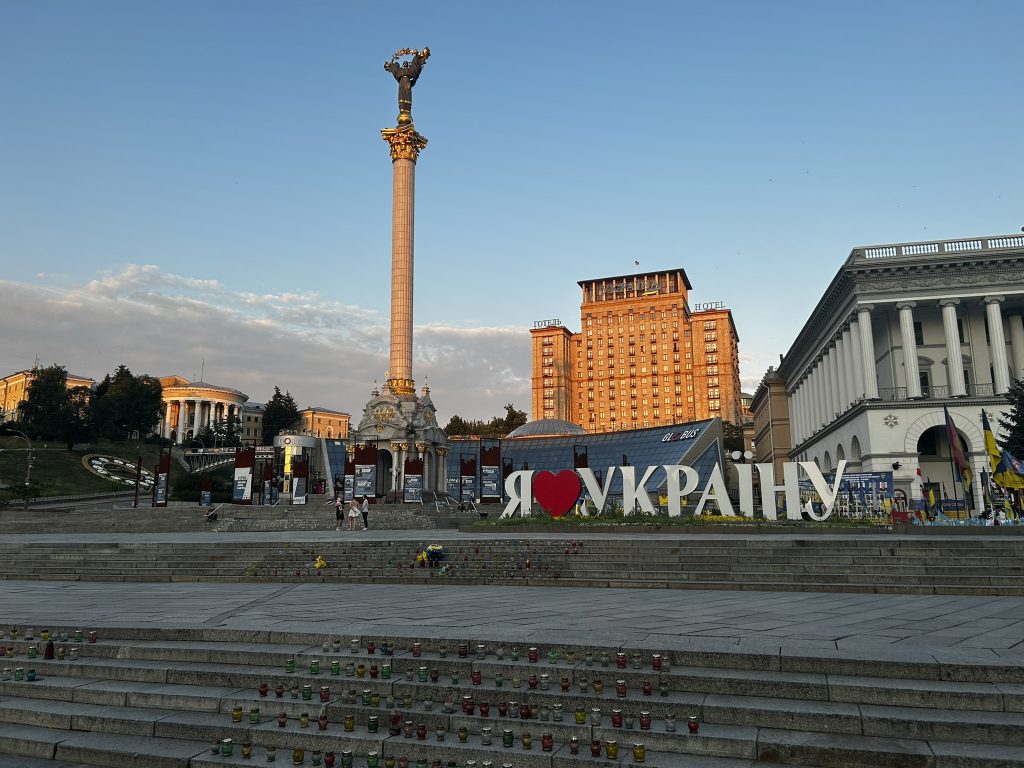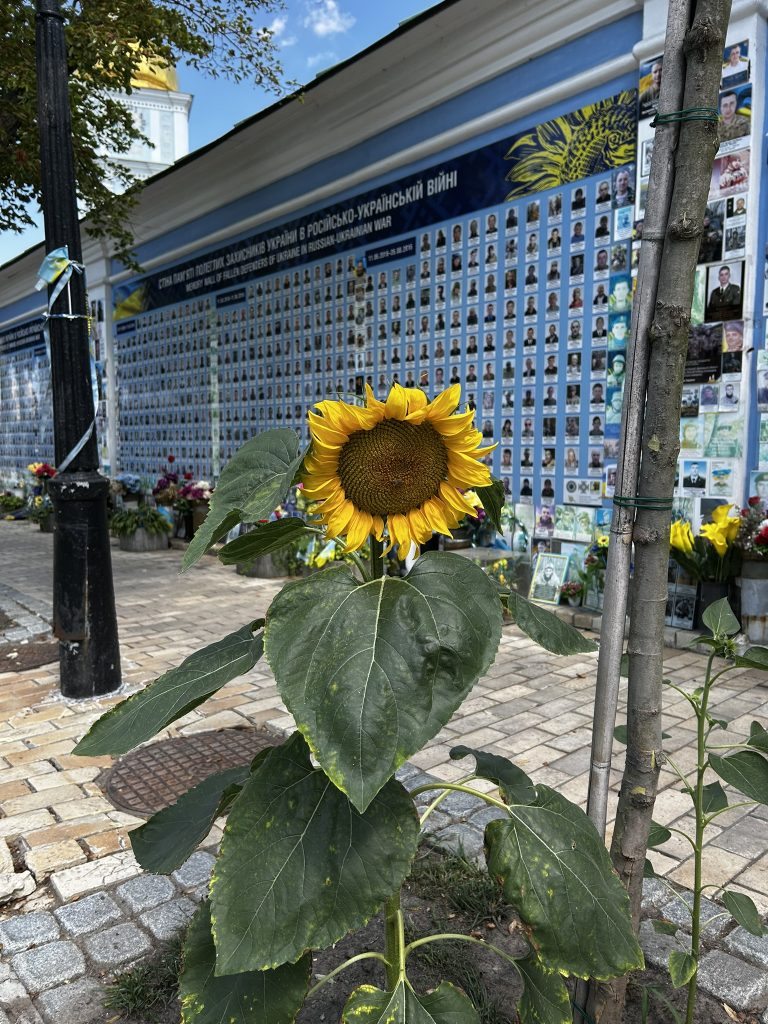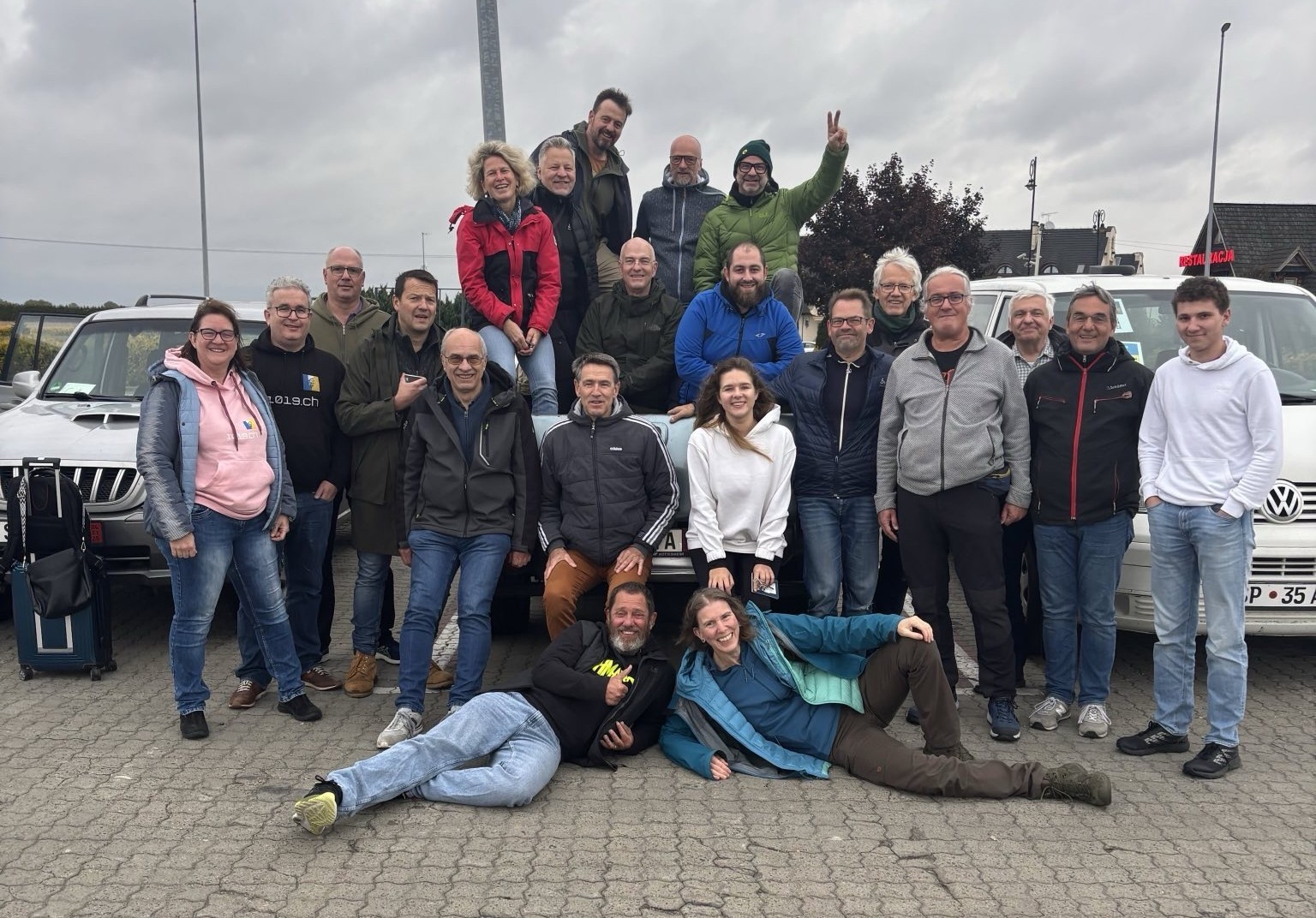We’re going to start this report a little differently.
For our April 2025 delivery, we were able to get bestselling author of Couchsurfing in Ukraine, Stefan Orth, on board, who later posted about his experiences without couch-surfing, but with pickup driving) on Twitter/X. This post was read by the head of Swiss aid organization 1019.ch, Martin Fussen, who contacted us. He requested assistance in procuring vehicles needed for evacuation purposes in Ukraine. We facilitated the connection between his organization, our partner organization Lawyers’ Move in Kyiv, and the army units, who then worked out the details. Through this collaboration, we were able to finance four vehicles for this 16th delivery with funds from Switzerland. Additionally, with the help of our friends, we expanded our search area: Oliver from the Rhine-Main region purchased a Mitsubishi L200 pickup on behalf of Pickup4Ukraine, Andreas in the Bonn region was back on board and procured a Mitsubishi Pajero, and Heinz from Bad Rappenau organized the purchase of a VW T5. Two more VW T5s, a VW T4, a Mercedes Sprinter for an orphanage in Kharkiv, and a small all-wheel-drive Subaru were added. This completed our convoy of 8 vehicles.
On the medical side, we received a lot of consumables from surgery here in the Rhine-Neckar region, a sterilizer, surgical instruments, and many ophthalmological consumables from Heilbronn, as well as a “Zeiss IOL Master”, a device for cornea measuring, from Dr. Schork in Schwaigern.
We would like to thank the doctors, clinics, and hospitals who donated valuable materials for the hospitals in Ukraine!
We especially want to thank Roman and Pavlo, two new friends of Pickup4Ukraine, auto mechanics, and their friends and supporters, for the workshop check and repair of some of the vehicles. This help ensured we were ready to go this time.
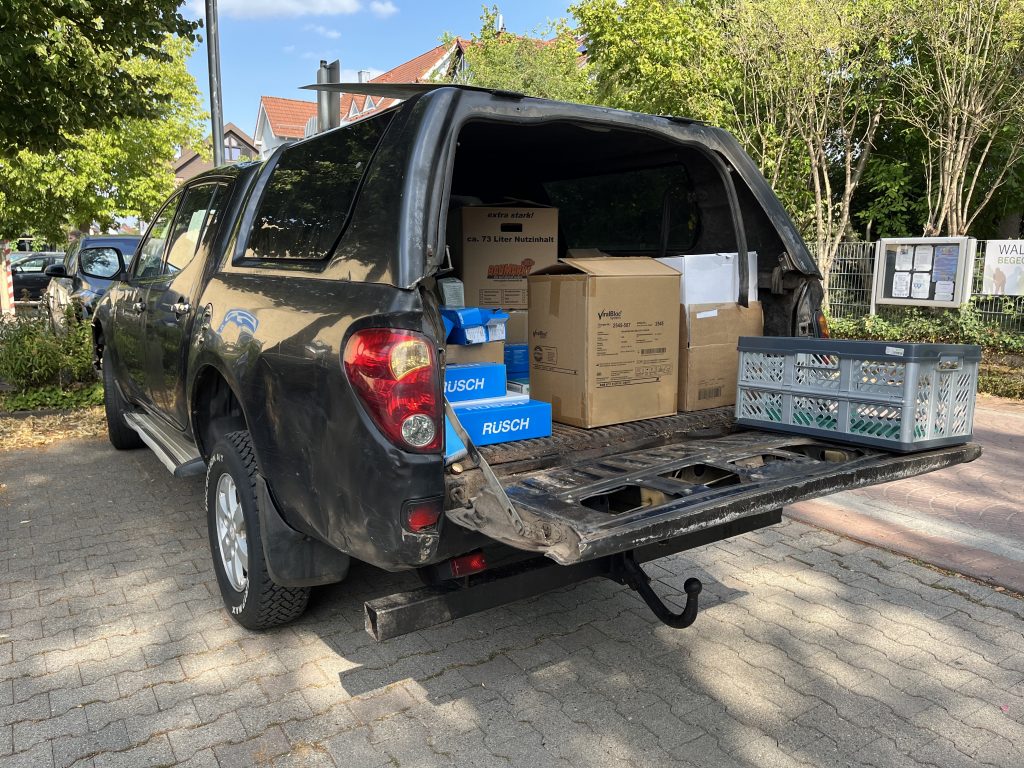
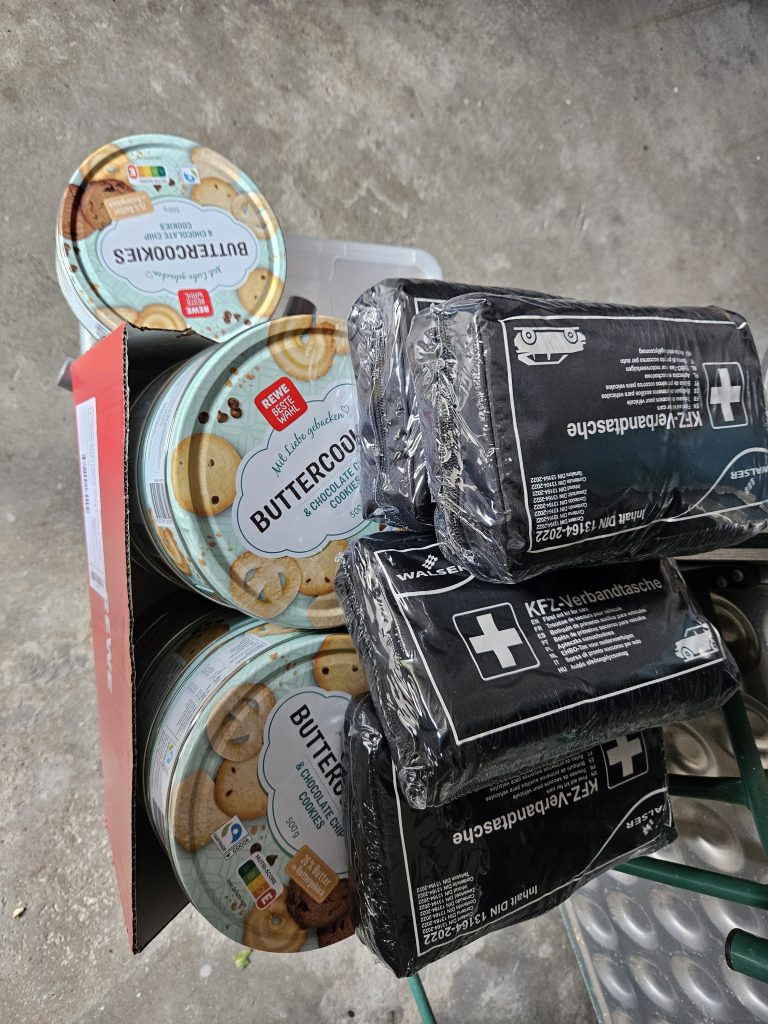
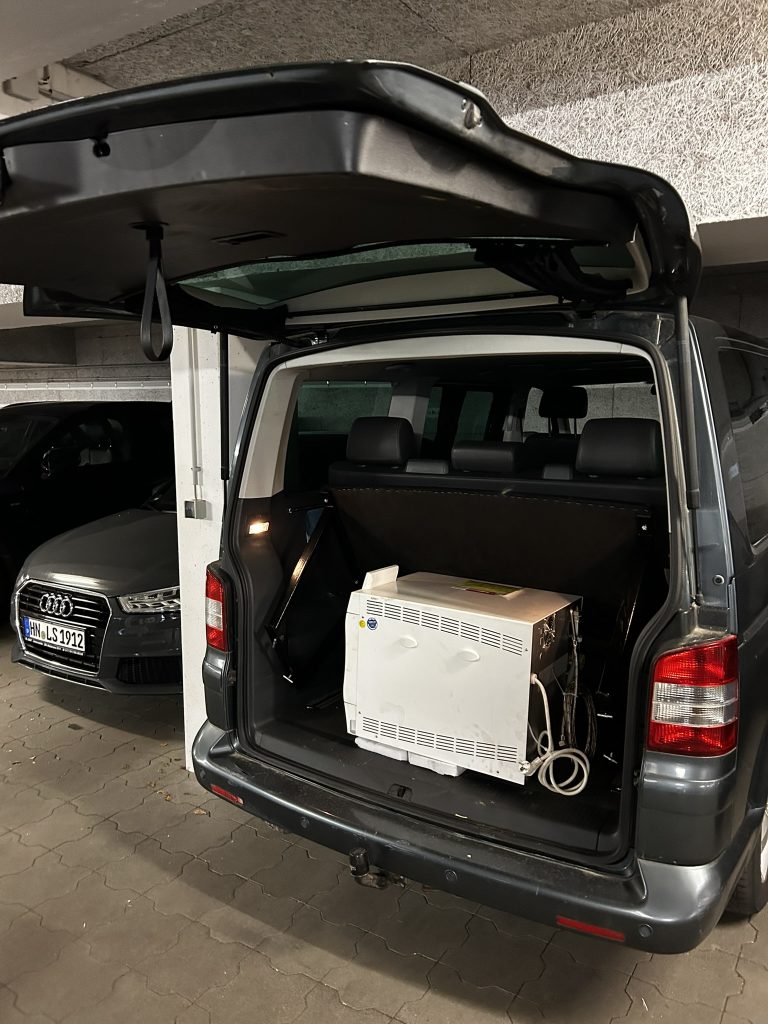
Wednesday, July 9, 2025
Since the Sprinter was speed-limited due to its number of seats, and the VW T4 bus, 29 years old, was slower than the other vehicles, we formed two groups for the first leg to the Polish-Ukrainian border. The first group, with the slower vehicles, started on Wednesday and covered the distance in two shorter runs. This allowed even these slow vehicles to arrive in Görlitz shortly after 1:00 PM on Wednesday, where we picked up Charlotte and Agnes at the train station. They had traveled by train from Berlin to join their first trip to Ukraine.
After a leisurely stroll through the old town of Görlitz and an ice cream on the Polish side of the Neisse, we returned to the highway with the vehicles to test the newly introduced Polish border inspections as “guinea pigs.” After the Polish border guards waved us through, our group reached the hotel for the night near Zgorzelec and concluded a relaxed day.
Thursday, July 10, 2025
The rest of the group set off early on Thursday morning, according to tradition, and met at the rest area shortly before 5:00 AM. We made good progress and were already past the German-Polish border by about noon, where we also met Andreas, who had started in the Bonn area. The border checks on the way into Poland were easy, and we arrived in Radymno in the evening. There, we met the drivers of the first group and took a big group picture – actually a little video.
In the middle of the night, we were asked to bring the key for one vehicle to the customs agency “so that the customs officer can check the VIN if necessary.”
Friday, July 11, 2025
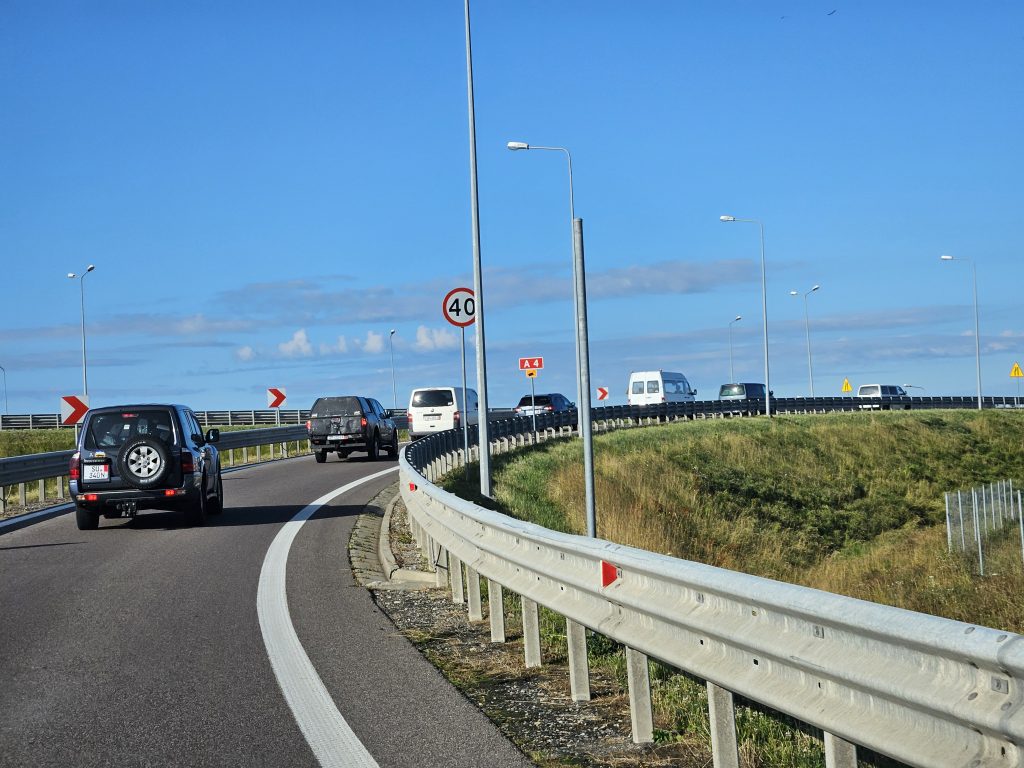
After a good breakfast, we headed to the border, and after a short wait, the first three, then six vehicles were able to enter the Polish part of the border facilities.
We were hoping for quick processing when unexpected obstacles arose. Unlike all previous 15 deliveries, the Polish customs officer now wanted a declaration for our humanitarian goods. Without a declaration, he would not process any vehicle. We would all have to turn back and “obtain the necessary papers.” The explanation that this had never been necessary before and that it was exclusively medical supplies did not persuade him. Finally, after lengthy negotiations in Polish, Andreas was able to reach a compromise with him and his superior, where only one vehicle was forced to turn back, and the rest of the convoy was allowed to proceed. Andreas and Sonja returned to Poland and unloaded their cargo, then later crossed the border without any problems. The rest of us were able to continue to the Ukrainian side, where everything went smoothly and quickly. We made a short stop for refueling and hot dogs after the border before heading towards Kyiv.
Heinz drove the Sprinter independently to L’viv and – acting also on behalf of 1019.ch and Martin Fussen – handed it over to the representative of Vysochynivske Dzherelo, an aid organization for internally displaced persons in Kharkiv, before starting his return journey.
They showed their gratitude almost immediately with two joy-filled videos.
We had agreed with Andreas and Sonja that, since they were driving a fast Pajero, they would simply catch up with us on the way to Kyiv. We planned to wait for them briefly at a rest area behind Rivne. But things turned out differently.
Andreas’ vehicle broke down, was towed to a gas station, and patched up to drive a few kilometers to a garage in the next village. There, the mechanics found out that a screw on the alternator had come loose, disconnecting it from the battery. After some searching, the screw was found and the alternator reconnected. However, this took time, so Andreas and Sonja only made it to Rivne that evening.
The rest of us arrived in the Kyiv region around 8:00 PM, and as we reached the city limits, the air raid sirens went off. We saw teams of soldiers and pickups mounted with machine guns stationed at bridges and other critical locations. They serve as air defense. They aim at the drones and try to shoot them down outside residential areas. In June alone, over 230 civilians were killed, and over 1,340 others were injured in Russian airstrikes on Ukrainian territory. The tactics of the Russian aggressor have changed. Hundreds of drones are launched at night, then group up and attack individual cities. This sometimes overwhelms Ukrainian air defenses. Often, ballistic or cruise missiles follow in order to cause maximum damage. The amount of explosives that each drone can carry has significantly increased. Sometimes, shrapnel is added. The drones fly faster and higher. All this has significantly increased the risk, so that we decided for our own safety to switch hotels and chose one in the low-lying Podil district that also has its own underground shelter with cots.
During air raids, the Ukrainians often jam GPS to confuse the drones navigating with GPS. Still, on the way into town, we managed to get the convoy to its destination without getting lost. We did it the old-fashioned way, with a static map on the phone and navingating using landmarks and intersections.
The air raid alert was over shortly afterward, and at the Hub, we met Ruslan from our Kyiv partner organization “Lawyers’ Move,” who welcomed us with soft drinks and pizza. We had a surreal pizza picnic in the courtyard under the evening sky of Kyiv.
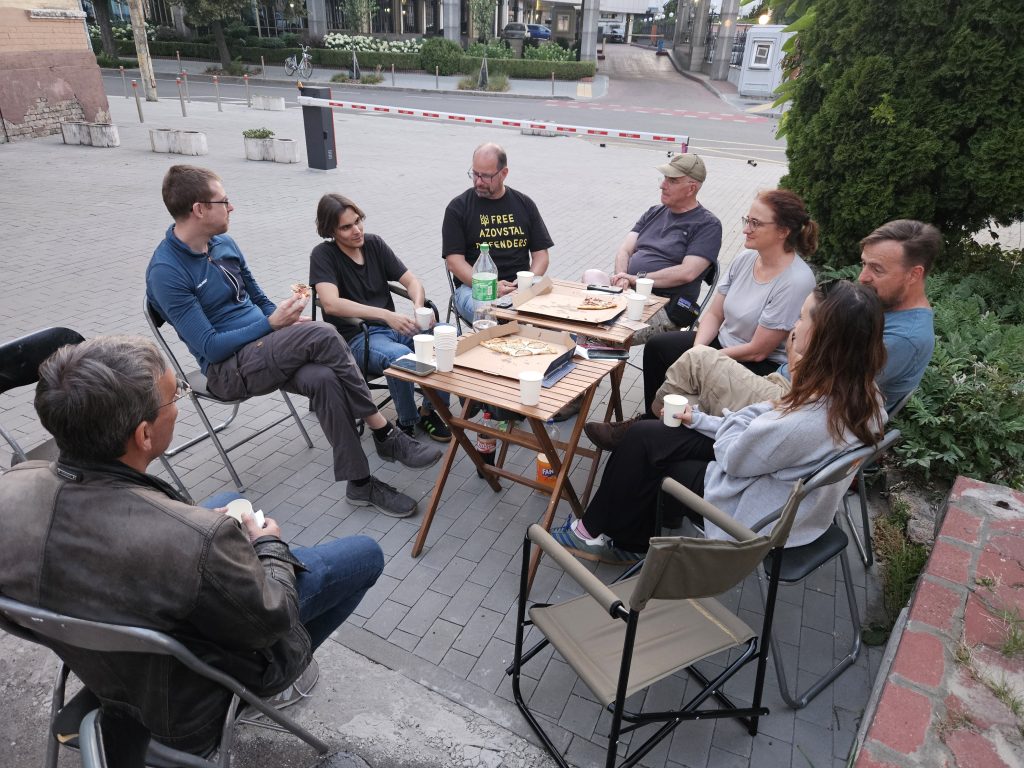
Afterward, we could walk to the hotel in Podil. We had barely settled into our rooms when the air raid alert went off again. We all went to the basement into the shelter and spread out on the cots. A beer to unwind. While we slept through the alarm in the shelter, residential buildings in other parts of Kyiv were hit by drones, rockets and debris over a period of five and a half hours.
On the way back to Poland, a fellow traveler from Kyiv later showed us footage from that night, which they had spent in the hallway instead of the underground garage of their apartment complex.
And then, upon returning to Germany, we find in the internet (here is also a link to the original publication) the Russian perspective on the purpose of these nightly terror attacks: The headline in Ria Novosti, the Russian news agency, translates to
“There is no other option: No one in Ukraine should be left alive.”
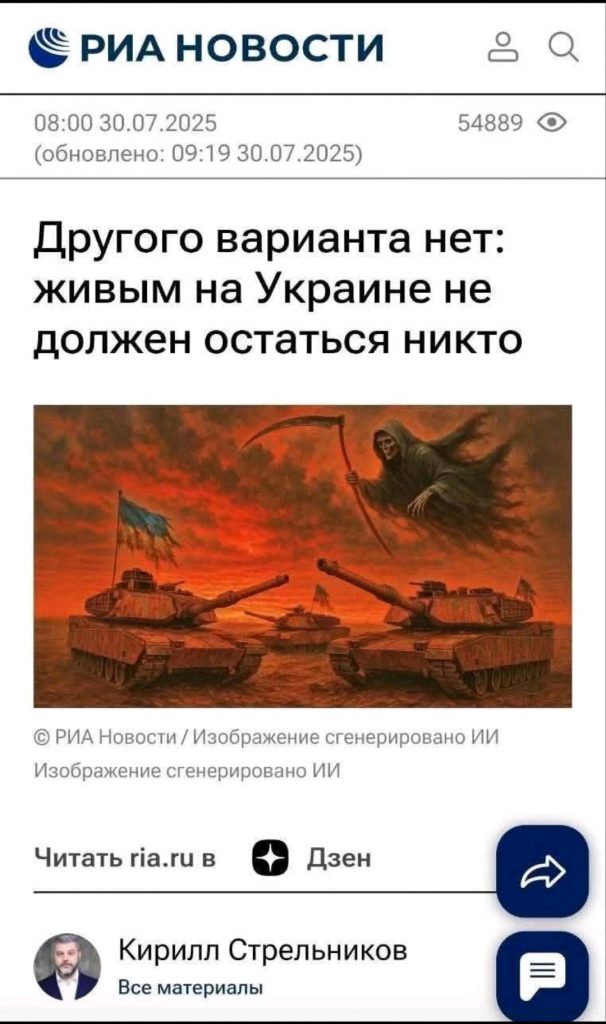
Saturday, July 12, 2025
This morning, we had breakfast together while Ruslan and Nadia set off to deliver a VW bus, converted into an evacuation vehicle from our April delivery, to Donbas.
Meanwhile, we met with Mariia at the Hub, unloaded the vehicles and had Mariia assess the contents. Following her guidance, we then repacked all the items that were to be sent to hospitals into three vehicles, which then headed to Nova Poshta. Some of us went along to Nova Poshta to help with the unloading, while others were able to sit down in a small café. We struck up a conversation with a young Ukrainian who told us that he had studied and worked in California but returned to Kyiv when the war broke out, to help in Ukraine in country.
Just before noon, we handed over our first vehicle: A unit recommended to us by the teacher couple Volodymyr and Olena had specifically requested a Subaru with all-wheel drive, and we were able to deliver the vehicle to them in eastern Kyiv. Andreas and Sonja also rejoined us here.
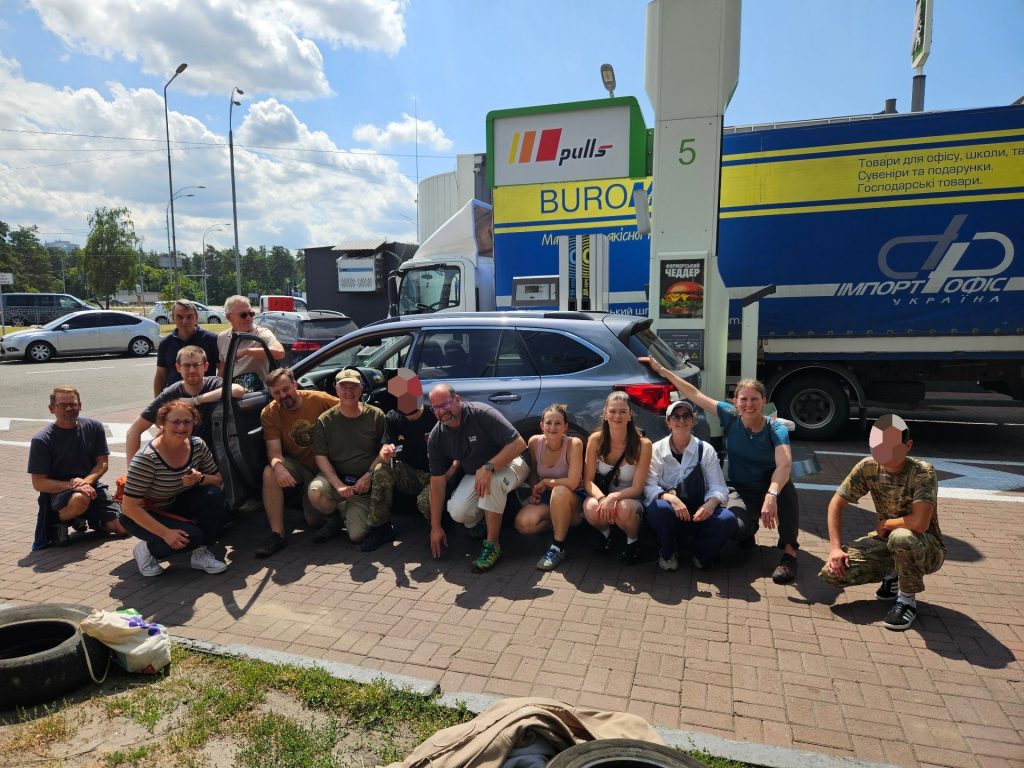
After that, we returned to Podil, where we had another handover, this time to a unit of the Ukrainian intelligence service. The unit had already received an off-road vehicle from us in December 2023. The guys were pleased with their new SUV, but, unsurprisingly, for security reasons, they did not disclose any details about its intended use. Confidential.
We spent the rest of the afternoon showing our first-time visitors around Kyiv and enjoying the good weather.
In the early evening, we met with Professor Ihor Zhaloba, whom we got to know last year through Malte.
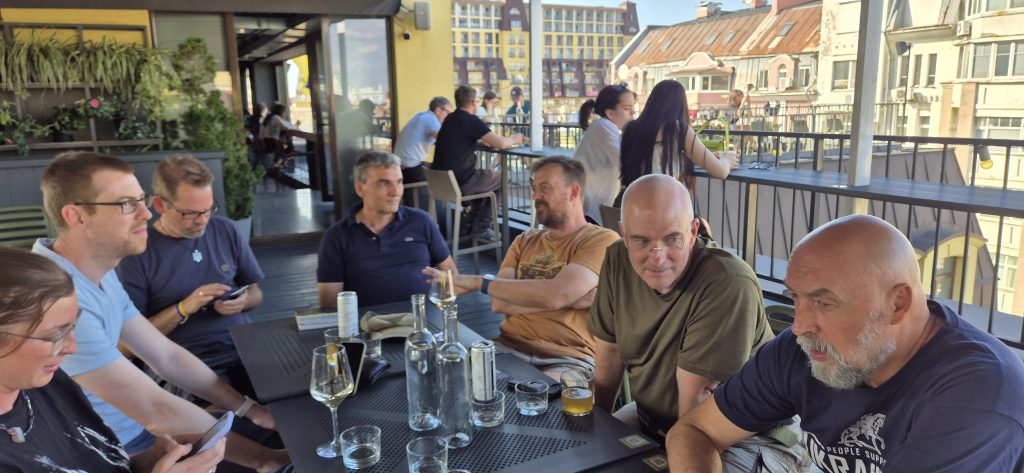
Ihor exchanged views with us and shared his insights on current military, political, and social issues.
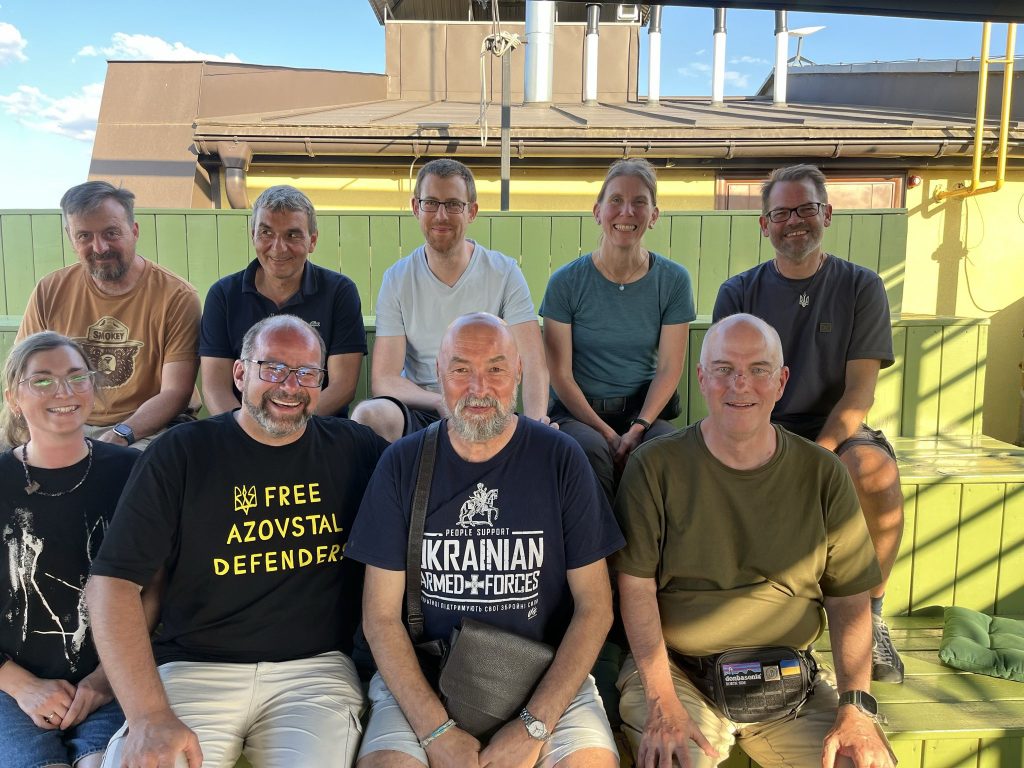
In the evening, Charlotte, Agnes, and Dani met with Bogdan. His mother and younger sister fled to Germany in March 2022 and became very close to the family of Charlotte, Dave, and Dani. Due to an air raid alarm, we did not meet in a restaurant as planned but first in the subway. Afterward, Boghdan showed us “his city,” with its vibrant nightlife, chic restaurants, and street music… life goes on.
In the evening, Michael and Annette took the night train to Mykolaiv to visit hospitals with Mariia and speak with doctors to whom we had provided equipment for neurosurgery and eye surgery in Ukraine with donations from the Czuzak Foundation in the USA. We will provide a separate report on this.
Sunday, July 13, 2025
Overnight, Nadia and Ruslan had returned to Kyiv.
After breakfast with Ruslan, Agnes, Charlotte, Dave, and Dani, joined him to drive the first newly acquired vehicle to the workshop, where its conversion into an evacuation vehicle would soon begin. Since Agnes and Charlotte were joining for the first time and, at 24 years old, were the youngest in our group, one of the auto mechanics took the time to explain what is important when converting the vehicles. For example, they replace the glass windows with aluminum sheeting to protect the patient and paramedic from glass shards caused by shock waves from explosions. They showed us a “jammer” that disrupts radio frequencies and thus repels drones. It was mounted on an already completed evacuation vehicle. However, it cannot counteract the new fiber-optic drones.
The incredible accomplishments of the rescue forces at the front, who not only evacuate and care for people with severe injuries but also risk their own lives, becomes more tangible in this workshop. The commitment of many people who logistically support the medics is plain. The auto mechanic told us that he does a significant part of his work free of charge, that parts of the costs for the conversions are covered out of pocket and through private donations from the families and friends of the emergency personnel, and that his partner longs for a time when he will have more time for his family again.
The others took advantage of the summer weather and walked over the long pedestrian bridge to the Dnipro Island to relax on the pebble beach with other Kyiv residents seeking recreation.
Most of our group took the night train back to Poland on Sunday evening. It departed on time despite the air raid alert. Malte and Nils stayed until Monday. On Sunday evening, Michael and Annette returned with Mariia from Mykolaiv to Kyiv by car.
Monday, July 14, 2025 / Tuesday, July 15, 2025
After a night in Kyiv without air raid alert, Malte, Nils, Michael, and Annette had breakfast with Ruslan in the morning. Then we met with Mariia at the hub to complete the documentation for the equipment we had procured for the hospitals in Mykolaiv.
Later, Nadia came to the hub, and we were able to go through the vehicle documentation with her. She also conveyed the special thanks of the 14th Independent Mechanized Brigade “Roman the Great,” to whom we had delivered a vehicle on a previous trip.
Finally, we had one last handover on Monday morning. The L200 was handed over to the very satisfied recipients of the 110th Brigade.
On this Monday, we also received short videos from the recipients of the Sprinter, expressing their sincere thanks for the vehicle, which is serving them well in transporting people and grocery shopping!
In the afternoon, we met with SAP colleagues for a walk through Kyiv, searching for red sculptures that the French artist James Colomina had placed at various locations.
After a shared dinner, we boarded the night train back to Poland. While we slept, the group that had already started the return journey on Sunday arrived at home.
We got home late on Tuesday evening after 27 hours door-to-door – thanks to Hansi for picking us up in Frankfurt!

